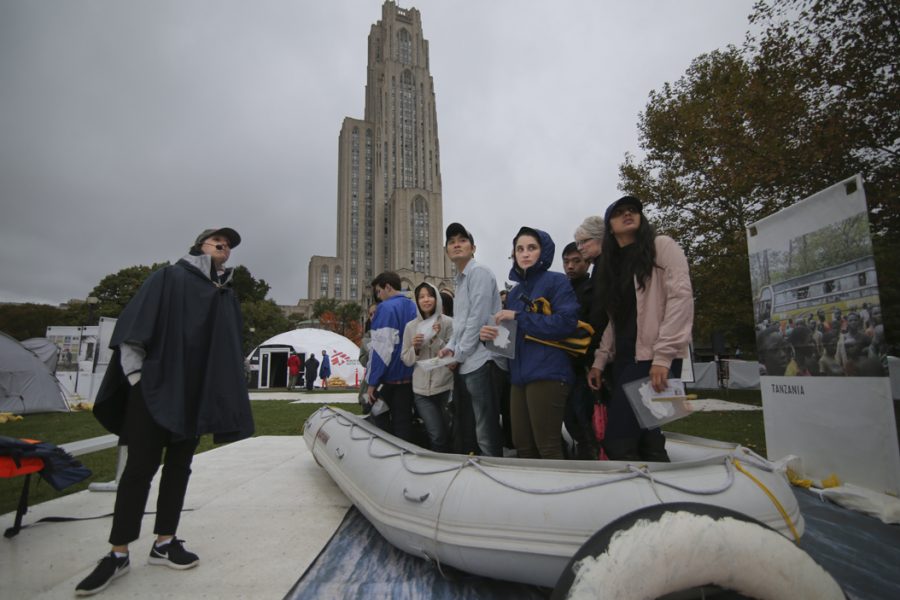When Kumi Matoba was about eight years old, her mother showed her an advertisement for Doctors Without Borders, depicting a picture of a malnourished child in Africa, belly distended.
The image seared itself into Matoba’s memory.
And soon after seeing it, she knew what her life’s mission would be — joining Doctors Without Borders to help children like the one she saw in the photograph. Eventually, she would do just that, becoming a pharmacist and traveling with the group to Uganda, Malawi and the Philippines. But now, she’s in Pittsburgh to help create an immersive refugee experience that has taken over Schenley Plaza.
From Oct. 27, through today, Doctors Without Borders, which also refers to itself as Medecins Sans Frontieres, offered Pittsburgh and visiting families, individuals and students the opportunity to experience its interactive outdoor educational exhibition, “Forced From Home,” a virtual tour of the journey and challenges that refugees encounter at various points.
As part of a tour that includes stops to Pittsburgh, Philadelphia, Manhattan, Boston and Washington, D.C., MSF aims to relate the humanitarian crisis to citizens in the U.S. and spread awareness about refugees and internally displaced people fleeing places such as Syria, Honduras, Afghanistan and South Sudan.
About 13 million people in Syria are in need of humanitarian aid, with the number of refugees tripling within four years of the start of the Syrian civil war. Today there are 65 million displaced people, with Syria, Turkey, Iraq, Lebanon and Jordan feeling the effects primarily.
MSF utilizes about 3,000 medical aid workers in over 60 countries — including the countries depicted in the exhibit — to meet the basic and medical needs of refugees, in addition to providing hospitals and vaccinations in camps.
According to MSF Media Coordinator Rachel Milkovich, the goal of the exhibit is to create a realistic experience of displaced people and to reach out to the active community and student population of Pittsburgh.
“The objective of the exhibit is to humanize the conversation around the refugee crisis and also talk about the 65.3 million people who are displaced,” Milkovich said. “And Pittsburgh is a really great medical center, it’s a place where there are a lot of universities, and we’re really interested in engaging with those communities.”
Upon entry into the exhibit, MSF workers hand participants an identity card which assigns them the role of asylum seeker, internally displaced person or refugee. Throughout the simulation, these roles determine the conditions of a visitor’s journey. Their means of travel, border treatment and camp location all depend on their legal status and the country they’re fleeing.
Tour guides then lead guests into a dome that offers a virtual experience of the refugee camps. There, visitors are surrounded by a 360-degree video where everyone is immersed into the ramshackled tents of Beqaa Valley, Lebanon, and the dirt roads of Tanzania.
After dividing visitors into sections according to country of origin, tour guides forced the “refugees” to select just five items to bring along with them for the journey ahead. Some had to give up possessions such as cell phones, shoes, family photos and passports.
The guide then lead the group from its war-torn homeland, either from Aleppo, Syria, to the Grecian island of Lesbos, or from Kabul, Afghanistan to Berlin. They are reminded along the way of the limited functionality of their life vests, made with cardboard and sponges, as well as the raft they would be embarking on — all in the midst of real fears of being kidnapped, tortured or trafficked.
Walking past the barbed wire and into the realm of unfamiliar faces of police officers and aids in entirely new countries, visitors saw how refugees are received.
White tents at the camp contained just the bare essentials: a table, a cot, tapestries and simple food items. There was a latrine, though it hardly deserved such a name, as it was simply a hole in the ground surrounded by a gray tarp affixed to wooden poles on each side.
In the center of the dirt floor there was a half-filled jug of water, meant to represent the mere two gallons refugees are given each day for drinking and hygiene. Rows and rows of full jugs stood beside it, though, depicting the 90 gallons used by the average American daily.
“People live here, cook here, raise children here,” said Matoba, the tour guide, stressing the effort put forth by refugees to persevere despite sparse resources and foreign surroundings.
She recalls how people would recreate the niches of everyday life at a refugee camp in Uganda, forming “restaurants,” springing up small markets, trading rations and meeting for tea.
In the medical tent, the rapid spread of disease due to poor hygienic conditions as well as pervasive malnutrition are the main concerns of MSF workers. At one point, Matoba held up a fist-sized nutrition bar, packed with 500 calories to combat weight loss in malnourished children.
Another immersive experience at the exhibit was the virtual reality tent, where visitors received a headset and earphones to transport them to refugee camps in places such as Afghanistan, Tanzania and Mexico.
According to Pitt first-year Zara Kaleem, the tour created an intense feeling of discomfort for its visitors and simulated a reality that is unattainable for anyone who has yet to travel to these destitute countries.
“It was very eye-opening to see exactly what happens, the whole process of it,” said Kaleem. “I wanted to come here, because I knew that it would open my eyes to the situations that are happening in the world.”
Participants were able to look into the weary eyes of refugees and listen to their stories of hardship face-to-face, working toward the organization’s goal of humanizing a topic which is often spoken of in vague, incomprehensible terms.
“I think it’s important that the exhibit shows what it feels like, what it looks like and what it means to be displaced,” Milkovich explained. “To tell the human side of the story.”


